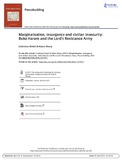Marginalisation, Insurgency and Civilian Insecurity: Boko Haram and the Lord’s Resistance Army
| dc.contributor.author | Dowd, Caitriona | |
| dc.contributor.author | Drury, Adam | |
| dc.coverage.spatial | Nigeria | en |
| dc.coverage.spatial | Uganda | en |
| dc.date.accessioned | 2017-04-19T09:04:20Z | |
| dc.date.available | 2017-04-19T09:04:20Z | |
| dc.date.issued | 2017-02-28 | |
| dc.identifier.citation | Caitriona Dowd and Adam Drury (2017): Marginalisation, insurgency and civilian insecurity: Boko Haram and the Lord’s Resistance Army, Peacebuilding, DOI: 10.1080/21647259.2016.1277011 | en |
| dc.identifier.issn | 2164-7259 | |
| dc.identifier.uri | https://opendocs.ids.ac.uk/opendocs/handle/20.500.12413/12948 | |
| dc.description | Keywords: Conflict, civil war, Nigeria, Uganda, religious violence, extremism | en |
| dc.description.abstract | Recent years have seen a dramatic escalation in the levels and intensity of violence associated with the northern Nigerian Islamist group, commonly referred to as ‘Boko Haram’. The deliberate and brutal targeting of civilians has been an increasingly pronounced feature of this conflict, contributing to acute civilian vulnerability. Often ascribed to the specific ideological and ethno-religious configuration of Boko Haram, we argue that this violence is similar to that of the Lord’s Resistance Army (LRA), tactically and in the evolution of both groups over time. In addition, violence inflicted on civilians by both groups has necessitated complex strategies of civilian navigation of insecurity risks, including the establishment of informal local security providers. Drawing on both quantitative conflict event data, and qualitative sources, we present a comparative analysis of Boko Haram and the LRA to demonstrate the importance of common strategies of group mobilisation, evolution in rhetoric and tactics, and armed state and non-state responses to insurgency, in driving violence against civilians in particular. The findings reflect the importance of shared local and historical conditions in producing violence; and placing civilian protection, and the multifaceted ways in which it is undermined, including by state responses, at the centre of peacebuilding theory and practice. | en |
| dc.language.iso | en | en |
| dc.publisher | Journal of Peacebuilding | en |
| dc.rights | This is an Open Access article distributed under the terms of the Creative Commons Attribution-NonCommercial-NoDerivatives License (http://creativecommons.org/licenses/by-nc-nd/4.0/), which permits non-commercial re-use, distribution, and reproduction in any medium, provided the original work is properly cited, and is not altered, transformed, or built upon in any way. | en |
| dc.rights.uri | http://creativecommons.org/licenses/by-nc-nd/4.0/ | en |
| dc.subject | Children and Youth | en |
| dc.title | Marginalisation, Insurgency and Civilian Insecurity: Boko Haram and the Lord’s Resistance Army | en |
| dc.type | Article | en |
| dc.rights.holder | © 2017 The Author(s) | en |
| dc.identifier.externaluri | http://www.tandfonline.com/doi/full/10.1080/21647259.2016.1277011 | en |
| dc.identifier.team | Conflict | en |
| dc.identifier.doi | http://dx.doi.org/10.1080/21647259.2016.1277011 | |
| dcterms.dateAccepted | 2017-02-13 | |
| rioxxterms.funder | Default funder | en |
| rioxxterms.identifier.project | Default project | en |
| rioxxterms.version | VoR | en |
| rioxxterms.versionofrecord | http://dx.doi.org/10.1080/21647259.2016.1277011 | en |
| rioxxterms.funder.project | c941507f-fd0b-4fc3-9822-4b2132f61a1d | en |
Files in this item
This item appears in the following Collection(s)
-
IDS Research [1661]
Except where otherwise noted, this item's license is described as This is an Open Access article distributed under the terms of the Creative Commons Attribution-NonCommercial-NoDerivatives License
(http://creativecommons.org/licenses/by-nc-nd/4.0/), which permits non-commercial re-use, distribution, and reproduction in any medium,
provided the original work is properly cited, and is not altered, transformed, or built upon in any way.


